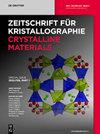两种新型多晶型(NaCl)[Cu(HSeO3)2]的合成和晶体结构:对层状亚硒酸氢铜家族的进一步贡献
IF 2.7
4区 材料科学
Q3 CRYSTALLOGRAPHY
Zeitschrift Fur Kristallographie-Crystalline Materials
Pub Date : 2023-03-30
DOI:10.1515/zkri-2023-0004
引用次数: 2
摘要
摘要:已知化合物(NaCl)[Cu(HSeO3)2]的两种新的多晶型晶体,我们称之为多晶型II和III,分别在母液下和K+存在下结晶沉淀约一年后形成。这两种结构都属于“层状亚硒酸铜”族。晶型II是(KCl)[Cu(HSeO3)2]的结构类似物,具有完全有序的Na+位点;主要区别在于Cu2+在(NaCl)[Cu(HSeO3)2]-II中的环境更为规则。与一些预期相反,含KCl的溶液结晶。NaCl、CuCl2和H2SeO3蒸发后不会形成混合的(Na1−xK x Cl)[Cu(HSeO3)2]晶体,而是形成(KCl)[Cu(HSeO3)2]和(NaCl)[Cu(HSeO3)2]-III的独立结晶,呈现出4个有序和1个无序Na+位的复杂结构。较长的结晶时间可能促进有序结构的形成。本文章由计算机程序翻译,如有差异,请以英文原文为准。
Synthesis and crystal structure of two novel polymorphs of (NaCl)[Cu(HSeO3)2]: a further contribution to the family of layered copper hydrogen selenites
Abstract Crystals of two new polymorphic forms of the known compound (NaCl)[Cu(HSeO3)2], which we term polymorphs II and III, were formed after a ca. one-year dwelling of a crystalline precipitate under mother liquor and upon crystallization in the presence of K+, respectively. Both structures belong to the “layered copper hydroselenite” family. The polymorph II is a structural analog of (KCl)[Cu(HSeO3)2] with a fully ordered Na+ site; the main difference concerns the environment of Cu2+ which is more regular in (NaCl)[Cu(HSeO3)2]-II. In contrast to some expectations, crystallization from solutions containing KCl. NaCl, CuCl2, and H2SeO3 upon evaporation does not result in formation of mixed (Na1−xK x Cl)[Cu(HSeO3)2] crystals, but rather in a separate crystallization of (KCl)[Cu(HSeO3)2] and (NaCl)[Cu(HSeO3)2]-III which exhibits a complex structure with four ordered and one disordered Na+ sites. It is possible that longer crystallization times enhance formation of ordered structures.
求助全文
通过发布文献求助,成功后即可免费获取论文全文。
去求助
来源期刊

Zeitschrift Fur Kristallographie-Crystalline Materials
CRYSTALLOGRAPHY-
CiteScore
2.00
自引率
16.70%
发文量
55
期刊介绍:
Zeitschrift für Kristallographie – Crystalline Materials was founded in 1877 by Paul von Groth and is today one of the world’s oldest scientific journals. It offers a place for researchers to present results of their theoretical experimental crystallographic studies. The journal presents significant results on structures and on properties of organic/inorganic substances with crystalline character, periodically ordered, modulated or quasicrystalline on static and dynamic phenomena applying the various methods of diffraction, spectroscopy and microscopy.
 求助内容:
求助内容: 应助结果提醒方式:
应助结果提醒方式:


